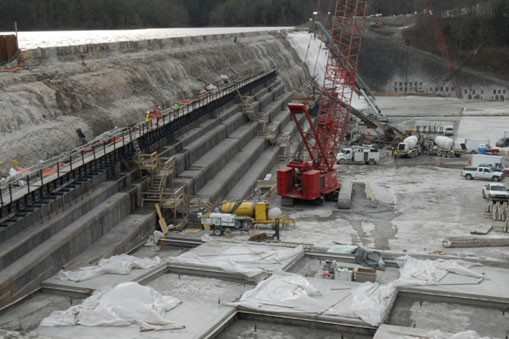 April 2, 2013 CONTACT: Adam Bosch (845) 334-7868 / Chris Gilbride (718) 595-6600 Department of Environmental Protection Tours Gilboa Dam Reconstruction With Local, State, and Federal Officials$400 Million Dam Rehabilitation among Largest Public Works Projects in CatskillsNew York City Department of Environmental Protection (DEP) Commissioner Carter Strickland today led a tour of the ongoing construction at Gilboa Dam to provide local, state, and federal officials, stakeholder groups, and the public with the latest information about the dam’s full-scale rehabilitation. The $400 million project includes reinforcing the dam with 234 million pounds of concrete, reconstructing the spillway, and installing a new release tunnel around the dam from Schoharie Reservoir into Schoharie Creek. Gilboa Dam has been in service for 85 years and impounds Schoharie Reservoir, the northernmost reservoir in the City’s water supply system. Reconstruction of the Dam is the largest public works project in Schoharie County, and one of the largest in the entire Catskills. The project has created roughly 125 local jobs. “The restoration of Gilboa Dam is an important project for the City and for communities in the Catskills,” Commissioner Strickland said. “The project ensures the safety and reliability of New York City’s water supply, while at the same time creating nearly 125 jobs for skilled tradesmen in and around the watershed.” Rehabilitation of the dam – initially scheduled to be complete in 2016 – is ahead of schedule. If work continues on its current timeline and weather conditions remain favorable, construction will be completed in 2014. DEP has installed more than three dozen post-tensioned anchors that improved the stability of the west retaining wall, in addition to the 80 anchors installed in 2006, to strengthen the dam by anchoring it into bedrock. DEP has also made significant progress on rehabilitating the concrete face of the dam. The original stone face of the dam had been damaged by years of freezing and thawing, which caused some of the stone to weaken and dislodge. The new concrete face will be carefully molded to look like stone. In late February, workers completed installation of the second of two temporary siphons that carry water out of the reservoir, over the dam, and into the creek below. Each of the siphons is roughly six feet in diameter at its widest point and is capable of releasing up to 250 million gallons of water a day. The siphons are an important component of the reconstruction plan because they allow DEP to lower water levels, providing work crews with access to portions of the dam that would otherwise be obstructed by water. A video of the siphon can be viewed here. The siphons will later be replaced by a new release tunnel – also known as a “low-level outlet” – which is expected to be finished by 2019. The permanent release tunnel will be capable of releasing roughly 1,500 million gallons a day from the Schoharie Reservoir. DEP manages New York City’s water supply, providing more than one billion gallons of water each day to more than 9 million residents, including 8.3 million in New York City, and residents of Ulster, Orange, Putnam, and Westchester counties. This water comes from the Catskill, Delaware, and Croton watersheds that extend more than 125 miles from the City, and the system comprises 19 reservoirs, three controlled lakes, and numerous tunnels and aqueducts. DEP has nearly 6,000 employees, including almost 1,000 scientists, engineers, surveyors, watershed maintainers and others professionals in the upstate watershed. In addition to its $68 million payroll and $153 million in annual taxes paid in upstate counties, DEP has invested more than $1.5 billion in watershed protection programs—including partnership organizations such as the Catskill Watershed Corporation and the Watershed Agricultural Council—that support sustainable farming practices, environmentally sensitive economic development, and local economic opportunity. In addition, DEP has a robust capital program with over $14 billion in investments planned over the next 10 years that will create up to 3,000 construction-related jobs per year. For more information, visit nyc.gov/dep, like us on Facebook at facebook.com/nycwater, or follow us on Twitter at twitter.com/nycwater. | ||